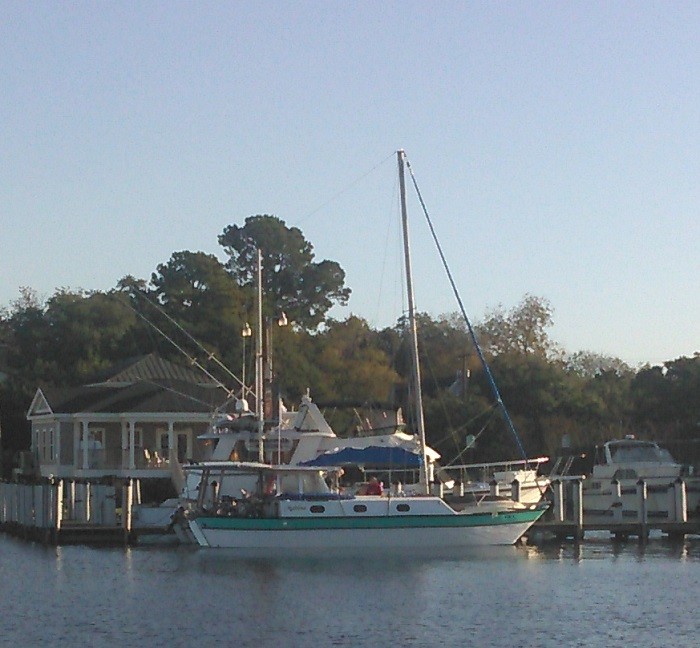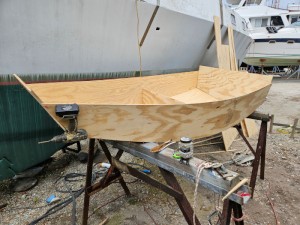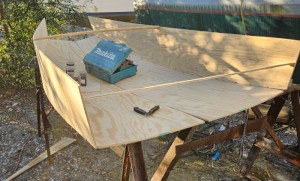Kaimusailing
s/v Kaimu Wharram Catamaran
| Vessel Name: | Kaimu |
| Vessel Make/Model: | Wharram Custom |
| Hailing Port: | Norwalk, CT |
| Crew: | Andy and the Kaimu Crew |
| About: | Sailors in the Baltimore, Annapolis, DC area. |
07 April 2024 | St. Marys, GA
Clammy Hands
Items came in from TEMU, the Chinese cut rate retailer. One was a nice little drone that cost about twelve and a half dollars. It looked like an easy thing to play with while I coughed and sneezed. I was fighting a summer cold, even though it is not summer elsewhere, it seems like it here. A nice [...]
02 April 2024 | St. Marys, GA
Sun Doggie
After laminating the cedar strips onto the gunwales of the dinghy I found the screws I used wouldn’t come out. The epoxy had seized them. The screw heads were stripped so I cut a straight slot in the heads with the cut off wheel. The cedar smoked when the screw heads got red hot. I could remove [...]
21 March 2024 | St. Marys, GA
Just Add Water
The rainy weekend started off with overcast and fog but no rain. It looked like I might be able to get something done on the D4 dinghy. I wanted to change the bow seat which is really the bow deck. The sailing option uses the deck to hold the freestanding mast. I didn’t like how the deck looked, [...]
01 March 2024 | St. Marys, GA
D4 Dinghy Alternative Seats
The rain event was more wind than rain, strong winds with gusts up to 44 mph. We drove into town to see what the harbor was like. There was a small sailboat that had dragged anchor and was sitting close to shore. The tide was out. We left and played with Bleu at Notter’s Pond.
23 February 2024 | St. Marys, GA
D4 Inside Seams
Day two of the dinghy build started out with me finishing wiring the hull bottoms together on the centerline of the bottom panels. This was much easier than the wiring of the chine edges of the bottom panels and the side panels.
15 February 2024 | St. Marys, GA
D4 Dinghy Day One
A Wharram Pahi 26 had been anchored in the river nearby the boatyard and was hauled out with the travel lift. I went around to look at it and talked to the owner couple. I was surprised that it had been built in Martinique in 1988. The boat is more than 30 years old.
For the Wharramites

.
Kaimu was derived from the Narai MK IV design and is similar in size to the original classic Ariki. I like the original Narai MK IV design, it has the bunks extend into the cabin spaces to provide seats at the ends of the cabins. It is a well thought out design. There is a lot of data over the years that is contained in the Sea People magazine that is archived on the wharram.com site. I can say that the hull and crossbeam design is bullet proof, the failures on Kaimu were of add ons, the roller furler, the stove in portlight.
.
The roller furler was subjected to repeated slamming due to the rig not having enough tension to keep the furler in column. It would not have surprised me if the forward bridle had parted due to metal fatigue. I will give up on trying to make a rigid furler work on this rig.
.
Kaimu's rig is a double triangle, which is two forestays and two shrouds to either side. This works well for the cutter rig, giving the headstay and an inner forestay for the staysail. The idea is that the rig can't come down until two stays fail in the same direction. There are also two running backstays to help tension the foresails when going to windward. The difficulty in getting tension into the rig is the same as with a little Hobie cat, you can tension the rig at the dock but when you go out sailing there is more bending and flexing and now the lee shrouds are loose. It probably isn't a good idea to remove every bit of slack.
.
One problem is taking on water through the forward hatches. These have to be as watertight as possible, because green water does come on deck. If water gets below the ability to rise to the sea becomes sluggish, more water gets below, and so on.
.
The cutter rig works well as the wind rises because it can reduce sail in a balanced fashion, right down to the point of having just the staysail up and then even reefing that. On Kaimu the routine was to roll up the genoa to reduce down to main and staysail, then drop the main to reduce down to just the staysail. The staysail is in the center of the boat with the foredeck as a working area, very safe to reef it, no need to go up forward on the bow ramp. Because the sail balance is maintained, the staysail can be used on any ordinary point of sail, upwind, downwind, reaching. I found the leeway in high winds is quite a bit and at one point was pointing NW but course made good was N. If you were caught in a gale in an enclosed bay it would be hard to sail out without using the motor. I used the motor to get off the lee shoal of Frying Pan Shoal when the microburst hit.
.
There is good ability to self steer in the Wharram design, especially upwind. Sheet the jib flat and then adjust the main to keep it close reaching or close hauled. Too much main will put her in irons, but when it is adjusted just right she'll sail along forever on that point of sail. Downwind she'll keep on course using just the headsail. The main will tend to bring her up into the wind. For some reason on our run down to Georgetown the swells wanted to broach the catamaran on every swell. On the reach to Beaufort on our first Frying Pan Shoal adventure the same thing happened with the swells. It is possible to set up a downwind tacking angle to reduce the tendency to broach.
.
I will try to avoid gales in the future, but these offshore forecasts seem to change by the hour at these capes. It is a sickening feeling to have NOAA come out with a gale warning when you're already well out to sea.
.
Here is a picture of a pretty Wharram ketch, probably a Tangaroa design, that stopped at the gas dock here as if on cue for this post.






